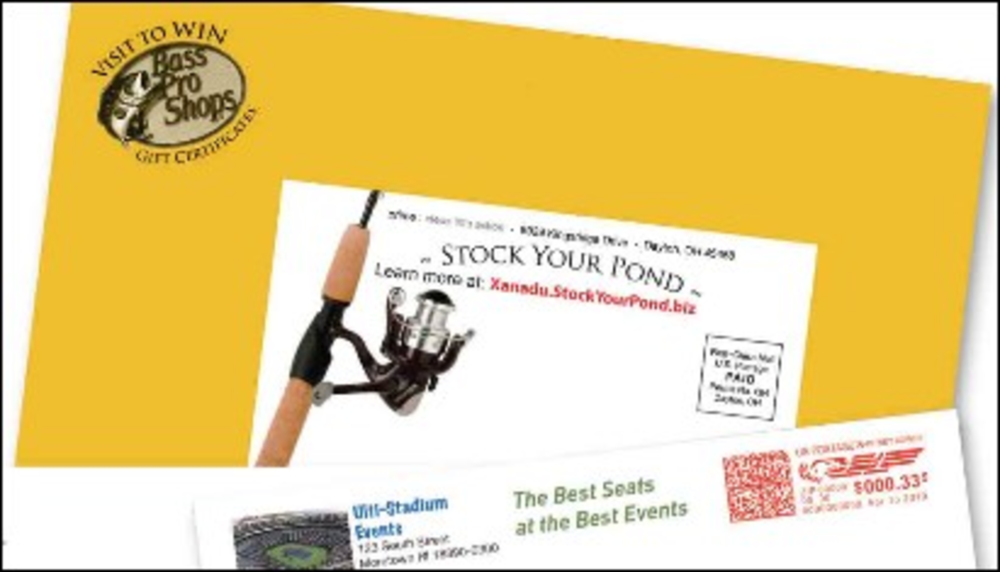Marketers know that generic direct mail won’t work on today’s savvy consumers. Instead, they are making use of recent developments in printing and production technology to enhance the outer envelope with customized messages, four-color printing and other embellishments. Marketers hope these improvements prevent their collateral from making a direct route to the trashcan by the hands of tuned out customers.
“The more information we can put on the outside of the envelope without it looking funky, the more apt recipients are to open it,” says Kelli Adkins, VP of integrated services at Prime, a commercial printer that specializes in personalized targeted marketing.
The printer found in its own mailings that the second- best response mechanism is a No. 10 envelope printed “with enough pertinent information on it,” Adkins notes. Some of that information includes a general URL address that enables Prime to track how many people responded to the envelope or some sort of message.
The company is also testing printing QR codes onto envelopes. When recipients scan the QR codes with their mobile devices, they are taken directly to a landing page for the division from which the mail was sent.
“We are trying to make envelopes more engaging,” says Adkins.
Using closed-faced envelopes — those that do not have a window for addresses — with any kind of personalized content means that the printer must include a “read and write system” that ensures the personalization inside the envelope matches that outside the envelope. Such systems are commonplace for printers doing insurance, medical and financial mailings, where there are strict privacy requirements. It is only in the past few years that general direct mail printers have made more wide use of this tactic, mostly in response to the needs of their customers.
Commercial printer Nies/Artcraft purchased four MCS Perfect Match Read and Print systems a couple of years ago to address the growth in higher-value, personalized direct mail it was handling. The camera vision systems are added onto its existing production line and track the production process at full speed. This allows personalized content to be printed inside a closed-faced envelope and variable content to be printed on the outside.
Most of Nies/Artcraft’s customers are currently using the technology to ensure that the address on the outer envelope matches up with the personalized content inside, reports John Kruszka, VP, fulfillment and mailing operations at Nies/Artcraft. But a telecommunications customer recently decided it wanted its acquisition mailing “to stand out.” It asked for a coated stock, closed-faced envelope with a six-word tagline and the customer’s first name printed in black on the front, says Kruszka. More than 2 million pieces were dropped and the effort produced “a high lift” in response, he adds. The additional cost for printing the tagline “was minimal,” he notes.
For many marketers the primary concern is keeping costs to a minimum, which is why more aren’t currently taking advantage of the prime real estate on the outside of the envelope, industry sources say.
“I wholeheartedly believe the value of leveraging the real estate of the envelope to initiate the dialogue with the target audience and increase response rates,” says Kenneth Botts, principal at branding firm Visual Marketing Associates.
Nonetheless, he points out that all of the direct mail campaigns recently developed by the firm were done with keeping costs at a minimum in mind and either involved a postcard or used a plain envelope. Many marketers consider price first and foremost.
Four-color printing, which has come down in price, is another strategy mailers can use to create an envelope with impact. Pitney Bowes recently introduced the Connect+ mailing system, which uses high-resolution HP inkjet technology to print promotional messages across the top of envelopes in color or black.
“Our research shows that color is the first and probably the most important factor in driving interest,” says Tim Troast, manager of marketing, mail finishing solutions, US mailing for Pitney Bowes.
The company’s research shows that 69% of consumers would be more likely to open a mail piece with color text and graphics compared to a plain white envelope without messaging.
“As communications become more personalized and relevant, full-color graphics will be the big differentiator when it comes to increasing the value of what consumers receive,” he continues. The system was designed to give midsize mailers the opportunity to cost efficiently and easily apply text and graphics to envelopes.
“With all of us trying to make our dollars work harder for us, the envelope is a good place to start your dialogue with your target audience,” adds Botts.
With cost efficiency and production improvements, it is possible “to use a whole other piece of the direct mail campaign to initiate a conversation for not a whole lot of additional cost,” Botts notes.







